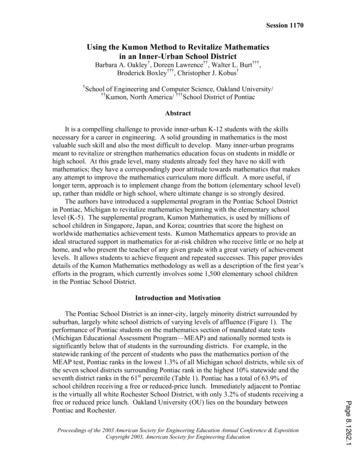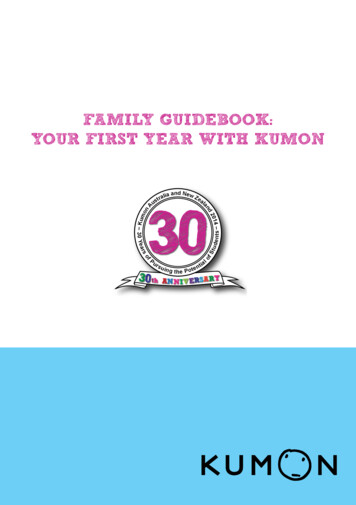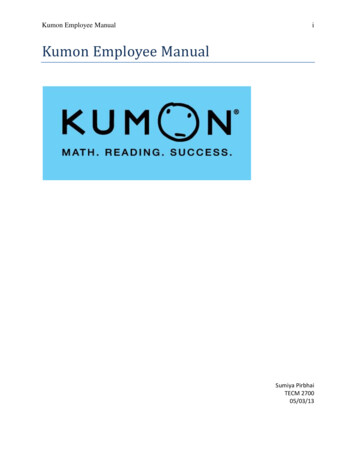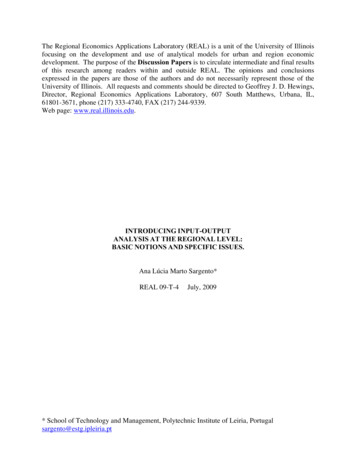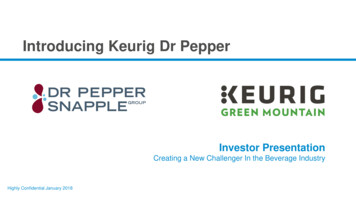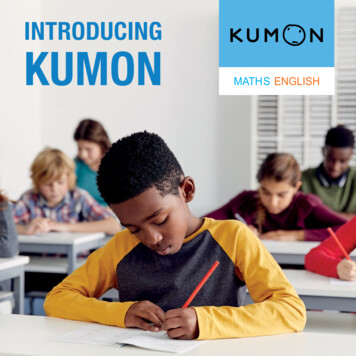
Transcription
INTRODUCINGKUMON
What is Kumon?Kumon is a unique method of learning maths and English designed to nurture eachchild’s ability to think and learn for themselves.Kumon Europe & Africa LimitedThe material used for this publicationis from accredited, well managed sourcescommitted to environmental sustainability,and printed using vegetable oil based inks.By studying the maths and English programmes, your child will develop their ability toself-learn and gain confidence as they progress through the programmes.April 2020Our aim is for your child to become able to think deeply for themselves and develop apositive attitude towards their learning.
How does Kumon work?Kumon offers individualised study programmes in maths and English that are tailored tosuit a child's needs through daily study and Instructor guidance.Our worksheet-based study programmes have evolved over the course of 60 years, aswe’ve learned from our students about how best to help them succeed, build confidenceand develop skills that allow them to learn for themselves.Kumon students complete daily Kumon study at home and attend their study centre onceor twice a week. The time taken to complete a day’s work may be around 30 minutes persubject, although this study time can vary.When visiting the study centre, students complete their assigned worksheets and areobserved and guided by the Instructor and a team of Assistants. Time spent at the studycentre allows the Instructor to support your child in their studies and ensure that theyare progressing well. Whilst at the study centre, students hand in work that has beencompleted and marked at home, and collect work for the following days until their nextstudy centre visit.
Kumon worksheets and your Kumon InstructorWhen introducing new concepts, the worksheets show example answers, clues and hints to helpstudents work out the correct process independently and then apply this to other similar questionsto increase their familiarity. The Instructor does not immediately give their students answers to theirquestions. Instead they carefully guide students to be aware of the focal points of questions andthink about the information that is given in the worksheet, supporting them to be engaged and solveproblems by themselves.The study is tailored to your child’s needs and ability by the Kumon Instructor. Starting at a comfortablelevel and progressing at their own pace, in small manageable steps, they will grow in confidence anddevelop pace, concentration and rhythm. Once the foundations have been established, the difficultywill increase in small steps that your child will be able to complete independently. This will allow themto enhance their self-learning skills and eventually go on to confidently study work beyond theirschool grade level.
We place value on children being able to think and learnfor themselvesKumon’s study programmes place great importance onself-learning, encouraging students to discover how to solveproblems, how to practise and try things out, and how to usetheir judgement. We believe that in equipping students to learnproactively, they will develop high academic ability and they’llhave the best chance of pursuing their short and long-termgoals and aspirations.Achieving things independently gives students a great senseof accomplishment and enthusiasm for studying. Motivationand self-learning are also important skills they’ll later benefitfrom at university and into adulthood, where independentstudy is a requirement and teachers are no longer available toteach them.We want our students to be able to think about the worldaround them and to be able to live in it with confidence.“It’s our job as educators not to stuff knowledge intochildren as if they were merely empty boxes, but toencourage each child to want to learn, to enjoy learningand be capable of studying whatever he or she may needor wish to in the future.”Toru Kumon
The Kumon programmes Toru Kumon founded the Kumon Method over 60 years ago with the aim of producing the greatestlearning effect in the shortest possible time by increasing a child’s ability and desire to self-learnEver since they were first devised, the Kumon programmes have been continually improved tomaximise student developmentOur programmes are designed so they can be completed by each and every student at their ownpace. Everyone has the potential to study above international standard and complete the Kumonprogrammes given the right supportThe programmes are open to children of all ages and we offer additional pencil skills worksheetswith colourful pictures to help younger children practise holding and using a pencil
The Kumon English Programme helps to developeach student’s ability to read and understand avariety of texts, and nurture a life-long habit ofreading for education and enjoymentThe Kumon Maths Programme helpschildren of all ages and abilities to developmaths skills and a love of numbersKumonCompleterThe Kumon MathsProgramme6Kumon levels N-O: CalculusSkills that students have built up throughout the maths programme culminate at this pointin their ability to complete advanced mathematical problemsbased on their calculation skills developed so farThey develop the necessary skills to progress further through self-learning5Kumon levels J-M: Advanced algebra and functionsStudents fully develop their algebraic skills before learning the basic properties of functionsThey gradually increase their understanding of functions by tackling problems ofgreater complexity4Kumon levels G-I: Calculation of algebraStudents master positive and negative numbers using the four operations, as well as algebraic expressionsand equations3Kumon levels E-F: Calculation of fractionsStudents get to grips with fractions, enabling them to complete addition, subtraction, multiplicationand division of fractions through examples and introductory problems2Kumon levels 3A-D: Calculation of whole numbers Students deepen their understanding of number sequence and are introduced to the main operations ofaddition, subtraction, multiplication and division1Kumon levels 6A-4A: Understanding of number sequenceStudents recite, read and understand number sequence, gradually increasing exposure to a larger range ofnumbers as they become readyThe Kumon EnglishProgrammeKumon levels J-L: Reading critically6 Students enhance their critical reading skills They are able to analyse text using evidence to justify their commentsKumon levels G-I: Summarising5 Students learn how to summarise text, identifying key words and their relationship to each other They learn how to answer comprehension questions concisely, drawing reasoned conclusionsfrom the information they have readKumon levels D-F: Identifying the topics of each paragraph4 Students work on grasping the flow of a story, identifying topics and main ideas By the end of Level F, they are able to unravel text and break it down to understand its topicand conclusionKumon levels A-C: Visualising a passage3 Students put together simple sentences and understand more about their structure, expressions and punctuation They build reading speed and work on sentence complexity, learning how to use the correct word order, verb formsand punctuationKumon levels 5A-2A: Learning to read and write2 Students learn to fluently read words and short sentences aloud They begin to trace words and learn letter sounds and how to blend them, all the time increasing their vocabularyKumon levels 7A-6A: Repeating and reciting Students repeat words, phrases and sentences, and begin to associate words with their meanings They become familiar with phrases and longer sentencesPencil Control Skills1
Exam successThe Kumon programmes are not designed to follow a school curriculum. Instead, as a globalorganisation, the programmes operate to complement curricula across the world. Regular Kumon studyover time will equip your child with the fundamental study skills they need to excel academically. Theskills our students develop, such as independent learning skills and confidence in ability, enhance theirperformance across all aspects of their school life, their extracurricular activities, and even exams!Kumon students become familiar with working with good pace. Through their long-term study, Kumonstudents build strong academic foundations in maths and English, as well as develop skills thatcontribute to exam success.Students become familiar with: Following instructions and reading questions carefullyManaging their time wiselyImproved concentration and ability to focusConfidence in their abilities which reduces exam stress
Supporting your childAt the Kumon centreThe support that your child receives at home and from you is crucial to their development. You will workin partnership with the Instructor towards the same shared goals; for your child to become a self-learner,completing advanced work beyond school grade level.Your child will attend the study centre up to twice a week. During class, they complete worksheets thathave been individually selected for them and interact with the Instructor and a team of class assistants.They’ll be nurtured to develop the abilities needed to self-learn advanced material.At Kumon, the study class supports your child to work well at home, and the homework in turn supportstheir learning in class.The time taken to complete a day’s work in the centre may be around 30 minutes per subject (this studytime is dependent on each individual and the programme level they have attained).Create a quiet and focused environment that allows them towork to their best ability.The Kumon study centre:Encourage your child to think for themselves by referringto previous examples and clues given to them on theworksheet. This is better for their long-term development.Mark your child’s work each day so they can learn fromcorrecting any mistakes. Focus on the long-term benefits and goals ofthe programmes.gives the Instructor the opportunity to observehow your child works and better match theworksheets to their growing skills and abilities;provides motivational surroundings wherepersonal interaction with the Instructor andassistants ensures your child always feelsencouraged and supported;provides an opportunity to explore new topics ina setting where the Instructor can give guidanceand feedback as necessary andallows your child to focus and work alongsideother students, benefiting from the excellentlearning environment that it provides.
In classArrival at classCollection ofclass folderHand in homeworkto assistantsHomeCollection ofhomeworkClass arking
Case studiesAlex18-year-old Alex, who completed the Kumon Maths Programmeand is currently studying a Mathematics Masters degree, said:“The Kumon Maths Programme has greatly improved my mentalmaths skills. I remember when I first joined Kumon at seven yearsold - I had little confidence in maths and struggled with it in school.I’ve come such a long way. Now, I enjoy the subject and confidentlystudy mathematics at an advanced level.”CarinaCarina, 14-year-old English programme completer, who passedthe 11 exam and gained admission into a prestigious Grammarschool, said:“Kumon has helped me develop a love of reading. The Englishprogramme has enabled me to think outside the box, which iswhy, I am more independent. What I enjoyed most about theprogrammes was looking forward to feeling proud of myself when Iscored 100%, or even when I was able to correct my mistakes andknowing how I could improve. Looking back, I have enjoyed seeingthe progress I have made over the years.”RithwikRithwik was just four years old when he began studying withKumon and he recently went on to complete the entire mathsprogramme before his tenth birthday, studying advanced worknormally tackled at A-level!Studying Kumon has allowed Rithwik to develop and honefundamental study skills. He says, “When other kids at school werelearning numbers, I could already do multiplications. Now, I amworking at GCSE level maths and I really enjoy it.”JamieNine-year-old Jamie, who joined Kumon at the age of six, is makingexcellent progress in the Kumon Maths Programme. He said,“Kumon has helped me learn how to master fractions and decimalsahead of what I was studying at school. It has also helped me alot in my schoolwork as I am now an expert at my times tables.Because of Kumon, I enjoy maths and find the work so much easierto understand.”
Where it all startedA history of KumonMore than four million children in over 50 countries around the world study with the Kumon Methodeach day.The founder of the Kumon Method, Mr Toru Kumon, was a maths teacher in Japan who wanted to givehis own son the best start in life. When he discovered that his Year 2 son, Takeshi, was not fulfilling hispotential in maths at school, Toru Kumon started creating worksheets for him to do at home every day.With daily practice, Takeshi’s maths ability naturally began to improve and so did his confidence.He studied small amounts of worksheets handwritten by his father every day and because they wereindividualised to his level at every point, he was able to progress smoothly and quickly to concepts farbeyond what he had experienced at school.Word got around and soon friends and neighbours were requesting worksheets for their children too,and a short time later the first neighbourhood Kumon centre was opened by Toru Kumon’s wife. Theycame to realise that these worksheets and this individualised approach to study could benefit any childaround the world and in 1958 the Kumon Institute of Education was established.Kumon’s success has spread across the world and the company was established in the UK in 1991.Even now, almost 30 years later, we still stand firm by the founding principles: All children have enormous and often untapped potential to excel Strong skills in language and maths are the key to all-round academic achievement All edu
Kumon levels 7A-6A: Repeating and reciting Students repeat words, phrases and sentences, and begin to associate words with their meanings They become familiar with phrases and longer sentences Kumon levels 5A-2A: Learning to read and write Students learn to

